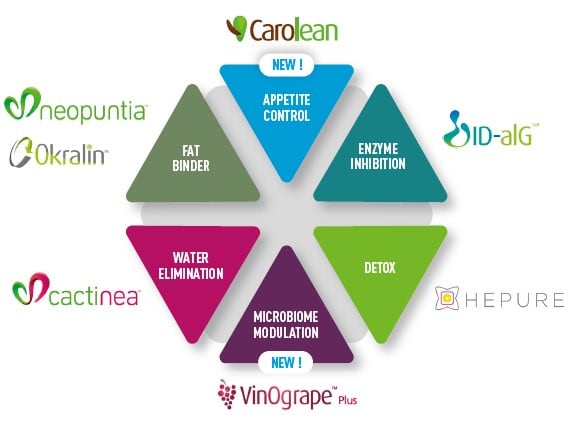Demand for GLP-1 medications has soared in recent years, causing market shortages in Europe and the rest of the world. Identifying an opportunity in the market, the brand has launched two branches of products.
The first includes products designed to act as a natural alternative to pharmaceutical weight loss drugs, while the second consists of supplements designed to alleviate burdensome symptoms caused by GLP-1 agonists.
Referred to as the Get Fit approach, the products offer a “full range of weight management solutions”, according to Leslie Lannebere, international marketing manager health at Nexira.
The rise of GLP-1 agonists
Originally developed for type 2 diabetes patients, glucagon-like peptide-1 (GLP-1) receptor agonists mimic the action of the GLP-1 hormone, reducing appetite, slowing digestion and controlling blood sugar levels.
In 2015, the European Medicines Agency (EMA) widened the application of GLP-1 medications, approving Saxenda (liraglutide) for weight management purposes, with Wegovy (semaglutide) following suit in 2022.
The approvals marked a quantum leap in weight management strategies, with one of the world’s top academic journals, Science, naming GLP-1 drugs as ‘Breakthrough of the Year’.
Not only does the medication hold the potential to dent obesity rates, but research suggests that GLP-1 agonists may reduce the risk of heart attacks and strokes and other obesity-related chronic diseases.
However, the drugs are not entirely risk-free, with roughly one in 10 GLP-1 users experiencing side effects such as nausea, vomiting, diarrhea and constipation. In addition, a significant portion of people regain at least some weight after stopping GLP-1 medications, with one study finding that participants regained two‐thirds of their prior weight loss.
This has driven demand for alternative weight loss solutions, as well as products which can alleviate the discomfort associated with the medication.
Supplements for appetite control
Nexira has launched two products for healthy weight management. The first is Carolean: a patent-pending complex combining carob (a member of the legume family) and nopal (also known as prickly pear cactus) for appetite control.
Designed to be taken instead of weight loss drugs or following a course of treatment to prevent weight gain rebound, Carolean promotes appetite control by acting in a similar way to GLP-1 medication.
Several studies have demonstrated Carolean’s efficacy through its ability to modulate levels of GLP-1 and ghrelin hormones, according to Damien Guillemet, scientific development director at Nexira.
While GLP-1 is released from the small intestine in response to food—delaying gastric emptying and promoting satiety, ghrelin is secreted when the stomach is empty, triggering feelings of hunger.
Guillemet previewed yet unpublished research showing that Carolean doubled GLP-1 secretion compared to the control, while significantly reducing ghrelin secretion by 67%. This resulted in a significant drop in overall food intake, with an average reduction of 47%.
“Carolean’s viscosity also slows down gastric emptying,” Guillemet told NutraIngredients. “By slowing down this process, Carolean impacts the neuronal pathway for satiety and hunger, reducing food intake.”
The second product is a natural grape extract known as VinOgrape, a prebiotic polyphenol concentrated in antioxidant compounds such as oligomeric procyanidins (OPC) and anthocyanins.
VinOgrape supports microbiome modulation by significantly increasing the abundance of Akkermansia muciniphila, a species of beneficial bacteria that has been linked to several benefits including lower adipose tissue and reduced waist to hip ratios.
Guillemet says research by Nexira shows that VinOgrape also appears to have positive effects on glycemia modulation and assists in the production of short chain fatty acids.
“We have a network of evidence showing that VinOgrape significantly boosts acetate levels, which is reported to increase satiety hormone secretion such as GLP-1 in the colon,” he said.
Nexira therefore positions VinOgrape as a versatile solution that has ‘endless nutraceutical applications’, from assisting with microbiome modulation to managing GLP-1 secretion through a prebiotic mechanism of action.
The company has also included several preexisting ingredients in the range that aim to aid detoxification, fat binding and water elimination.

Supplements for GLP-1 side effects
Alongside these appetite suppressors, Nexira has launched a range of products to assist with GLP-1-related side effects, including gut disturbances and additional nutritional needs.
“The number one problem with GLP-1 medication is related to gut health,” said Guillemet. “In these instances, our primary recommendation would be acacia fiber.”
Nexira’s Inavea is an organic prebiotic acacia fiber which stimulates the production of healthy bacteria and contributes to short chain fatty acid production.
“Acacia fiber is fermented very slowly throughout the colon, making it a very gentle fiber compared to other solutions,” said Guillemet. “It has been demonstrated in studies that it produces significantly fewer side effects and less discomfort compared to other fibers such as inulin.”
In addition to their impact on gut health, GLP-1 medications can cause muscle loss and a lack of energy due to reduced nutritional intake.
For muscle loss, Nexira recommend Prothy, a hydrolized rice protein which is rich in all essential and semi-essential amino acids, while ginseng, guarana and the Cognivia-branded vegetal nootropic are recommended to improve energy and focus due to their ability to replenish energy stores and boost cognition.
Finally, three products are recommended to fill nutrition gaps including Simag, a natural marine magnesium, Acerola, a natural source of vitamin C, and MCT oils, a supplement made from medium-chain triglycerides.
This range of products shows Nexira is aiming to support the entirety of GLP-1-related requirements, according to Lannebere, with specific products for specific needs.
“I’m not sure that having one product that does everything from the floor to the ceiling is the best option,” she said. “Having one ingredient that has a specific action is a better way to address consumer need.”



